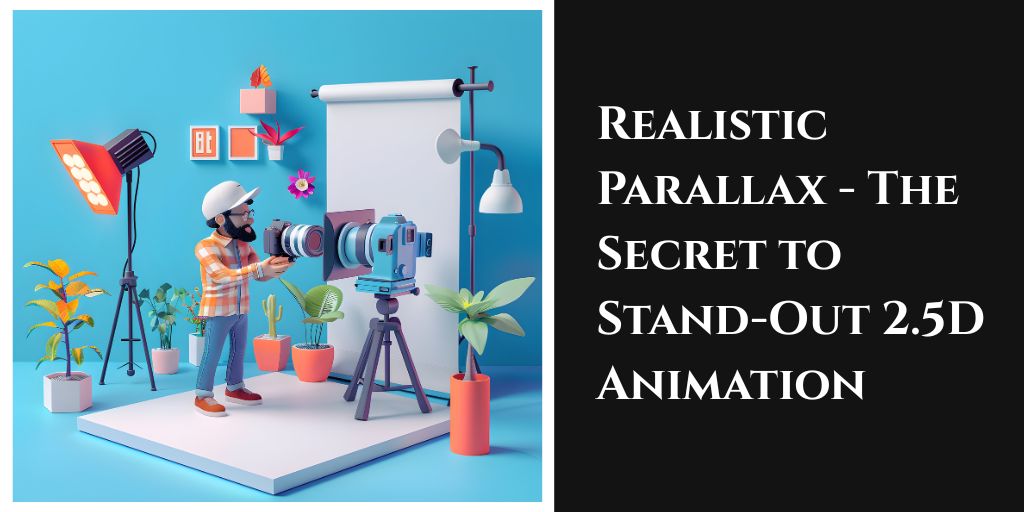Picture an Parallax effects mimic how we see depth in real life. When you walk past a park, nearby trees move quickly, while distant mountains barely shift. The difference in speed creates a convincing illusion of depth. animation where the background fades deep into the distance, and the foreground feels like it’s right within your reach.
That’s 2.5D animation—it gives flat 2D scenes real depth without complex 3D modelling.
The trick? Parallax effects. By moving layers at different speeds, they create a 3D feel.
Whether you’re just starting out or want to step up your game, this guide will show you how to make it pop.
What Are Parallax Effects?
In 2.5D animation, you recreate this by dividing your scene into layers—foreground, mid-ground, and background—and moving them at varying speeds as the camera pans.
Games like Ori and the Blind Forest use this technique to bring static visuals to life with rich, dynamic movement.
Steps to Make Parallax Effects Pop
1. Plan Your Scene
Start with a concept. Sketch out what’s in your animation, like a character running through a city. Figure out which elements should be in the foreground, which ones fit in the middle, and what belongs in the background. This helps you organise your layers for maximum effect.
2. Break Into Layers
Use your animation software—such as Adobe After Effects, Moho, or Spine—and separate each element into its own layer.
For example, in a city scene, the character and street signs would go in the foreground, buildings in the midground, and sky or clouds in the background..
3. Add a virtual Camera
Most modern animation tools support virtual cameras. In After Effects, you can add a 3D camera and adjust its position to simulate movement. This camera becomes the lens through which your audience sees the parallax.
4. Set Up Depth
Assign depth using the z-axis. Closer objects get smaller z-values, while distant layers get higher ones. The bigger the difference in depth, the more dramatic the parallax effect will be. Close layers feel calm and smooth; spread them out for a strong, movie-like punch.
5. Move the Camera
Animate the camera with keyframes, pan slowly, or zoom quickly to enhance parallax movement. As it moves, your layers will shift automatically based on their depth, creating that sweet parallax vibe.
6. Tweak the Movement
Fine-tune how fast each layer moves. Foreground stuff should slide quicker, background slower. You might even scale up close layers a bit as they “get nearer” to the camera, just don’t overdo it, or it’ll look weird.
7. Polish with Details
Add shadows that shift with the layers or lighting that changes as the camera moves. Little touches like these make your 2.5D animation feel real and immersive.
Pro Tips to Level Up
Want your parallax effects to wow everyone? Then try these extra ideas:
1. Play with Perspective
Some tools let you tilt 2D layers a tiny bit, like they’re in 3D space. It’s a neat way to boost that depth feeling without going overboard.
2. Use Depth of Field
Apply a slight blur to background layers to mimic how our eyes focus on closer objects. This technique boosts realism and pinpoints the viewer’s attention on the core action.
3. Scale with intention
Make closer objects grow slightly as the camera zooms in or moves past. Keep the scaling subtle to maintain a natural look.
4. Smooth Out Edges
When you split your scene into layers, the edges can look choppy. Use masking or feathering in your software to blend them so it feels like one big picture.
5. Mix Up Camera Moves
A slow side-scroll can feel peaceful, while a fast zoom pumps up the energy. Use camera motion that mirrors your animation’s mood to deepen emotional connection in 2.5D scenes.
Watch Out for These Slip-Ups
Even seasoned 2.5D animators can easily fall into these traps. Here’s what to watch for:
1. Mixed-Up Layers
If the foreground is behind the background, your depth will be all wrong. Double-check your layer staking.
2. Too Much Speed
If layers move too fast or too slowly, the animation can feel jarring. Fine-tune speed for smooth, believable motion.
3. Shifting Horizon Lines
When working with outdoor scenes, maintain a steady horizon line across all layers. A jumping horizon throws everything off.
4. Inconsistent Lighting
Ensure lighting and shadows remain consistent across all layers as the camera moves. Mismatched lighting kills realism.
Avoid these missteps, and your parallax 2.5D animation will look polished and professional.
Why Bother with Parallax?
Parallax effects aren’t just cool, they’re a game-changer. They make your animations more fun to watch, pulling viewers into the world you’ve built.
Plus, 2.5D animation with parallax is easier and faster than full 3D, saving you time while still looking awesome. The perfect fusion—timeless 2D artistry enriched with the depth and power of 3D.
Ready to create 2.5D animations that burst with real, captivating depth? Work with an experienced animation studio in Singapore that brings your ideas to life with smooth parallax effects and creative visuals.
Whether it’s for ads, games, or explainer videos, great animation makes a big difference!






